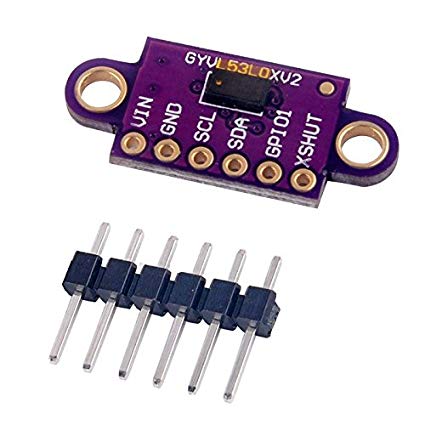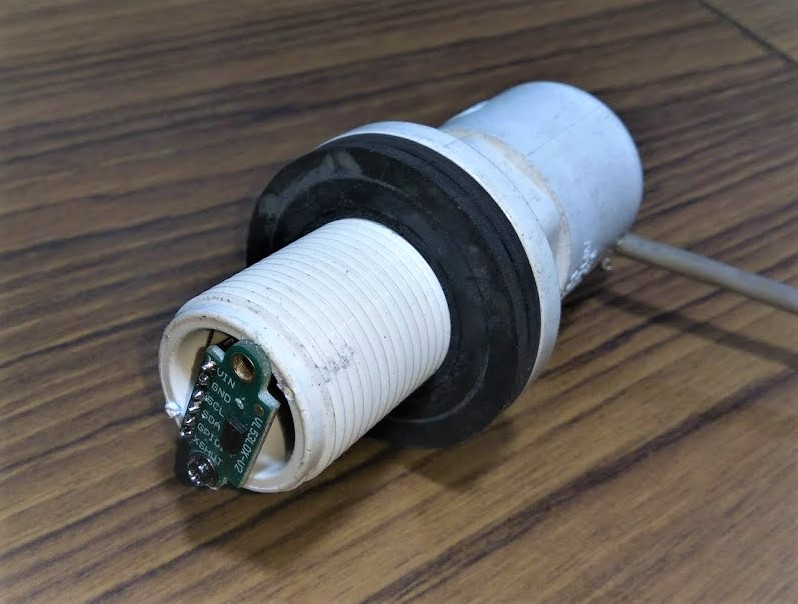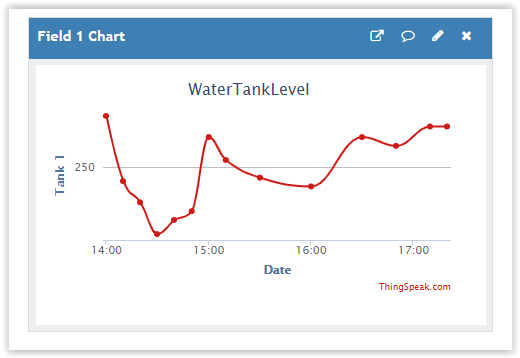Trouble with the JSN SR04T
-
@sundeep-goel Looking back at the tank photo your inlet is at the opposite side of the tank and presumably your sensor head is just over 200mm to the top water level when full? There should be no way that head is seeing the float when full even if the float is directly below the hatch.
I'm confused by what you are saying about the board - Accepted it is the 5v version, but you say you are detecting echo away from the tank, but is the distance reliably and consistently correct?
Presumably this is via a 5v-3.3v level converter?You misunderstood the bend suggestion - Ultrasonics don't handle bends well but cables do ;). I was looking at the possibility of extending the cable pipe with the sensor on the end pointing down nearer centre. Unfortunately that will be very close to the float if it's a long arm.
What you could try is tying the float up until level drops and hang the sensor through the hatch and to see if it works reliably there.
If it does, you may have to find a source a replacement float valve with a shorter arm, or possibly find a compact version usually marketed as "silent" (The float in these rises up a tube to close the valve, but unlike the arm type they run at full flow longer until the last few cm).
Let's see what your tests reveal....@zboblamont said in Trouble with the JSN SR04T:
hang the sensor through the hatch and to see if it works reliably there
Got you, will try this and a couple of others. Will post back the results.
On a related topic, is this sensor good sensing water level [link text](GY-VL53L0XV2 Laser Distance Module I2C IIC 3.3V/5V
https://s.click.aliexpress.com/e/73Fe2bm) -
@zboblamont said in Trouble with the JSN SR04T:
hang the sensor through the hatch and to see if it works reliably there
Got you, will try this and a couple of others. Will post back the results.
On a related topic, is this sensor good sensing water level [link text](GY-VL53L0XV2 Laser Distance Module I2C IIC 3.3V/5V
https://s.click.aliexpress.com/e/73Fe2bm)@sundeep-goel No idea !
-
@sundeep-goel No idea !
@zboblamont said in Trouble with the JSN SR04T:
The sensor is working perfect outside the tank - tested both with 10us and 15us. Also, same with / without a voltage divider.
Saw a possible issue in the code
Ultrasonic ultrasonic1(4, 13); // An ultrasonic sensor HC-04 Ultrasonic ultrasonic2(4, 12); // An ultrasonic sensor HC-04Was using same trigger pins on the esp for both sensor, ideally this should not have been creating a problem. but just to be sure, tried with only one sensor - worked fine outside the tank
Inside the tank in all cases, back to square one i.e. readings between 20-25cm only.
For now , putting this sensor aside and switching to the IR laser sensor VL53L0X. Lets see how that does, will post back the results soon
-
@zboblamont said in Trouble with the JSN SR04T:
The sensor is working perfect outside the tank - tested both with 10us and 15us. Also, same with / without a voltage divider.
Saw a possible issue in the code
Ultrasonic ultrasonic1(4, 13); // An ultrasonic sensor HC-04 Ultrasonic ultrasonic2(4, 12); // An ultrasonic sensor HC-04Was using same trigger pins on the esp for both sensor, ideally this should not have been creating a problem. but just to be sure, tried with only one sensor - worked fine outside the tank
Inside the tank in all cases, back to square one i.e. readings between 20-25cm only.
For now , putting this sensor aside and switching to the IR laser sensor VL53L0X. Lets see how that does, will post back the results soon
@sundeep-goel said in Trouble with the JSN SR04T:
putting this sensor aside and switching to the IR laser sensor VL53L0X.
replaced JSN SR04T with VL53L0X

So far the tests in a experimental setup (i.e. using a mug of water as a reflective surface are good), will install in the tank tomorrow morning, fingers crossed.
-
@sundeep-goel said in Trouble with the JSN SR04T:
putting this sensor aside and switching to the IR laser sensor VL53L0X.
replaced JSN SR04T with VL53L0X

So far the tests in a experimental setup (i.e. using a mug of water as a reflective surface are good), will install in the tank tomorrow morning, fingers crossed.
@sundeep-goel said in Trouble with the JSN SR04T:
will install in the tank tomorrow morning, fingers crossed
Installed under a tank nipple (needed to attach to lower end, was getting issues at the end)

getting steady readings now

in brief, too many issues with the JSN SR04T sensor in my tank, Laser TOF Sensor VL53L0X is better and cheaper in given setup.
-
@sundeep-goel said in Trouble with the JSN SR04T:
will install in the tank tomorrow morning, fingers crossed
Installed under a tank nipple (needed to attach to lower end, was getting issues at the end)

getting steady readings now

in brief, too many issues with the JSN SR04T sensor in my tank, Laser TOF Sensor VL53L0X is better and cheaper in given setup.
@sundeep-goel Glad you found a solution, hopefully it will continue to prove reliable over time in your environment, presumably dust is not a problem from the presence of water, nor condensation through ventilation (loose lid)
Out of curiosity, what the range is that version, I've seen 1m and 2m quoted for the same model number..? -
@sundeep-goel Glad you found a solution, hopefully it will continue to prove reliable over time in your environment, presumably dust is not a problem from the presence of water, nor condensation through ventilation (loose lid)
Out of curiosity, what the range is that version, I've seen 1m and 2m quoted for the same model number..?@zboblamont said in Trouble with the JSN SR04T:
what the range is that version, I've seen 1m and 2m quoted for the same model number..?
I have tested till around 2meters succesfully. I read somewhere that you can also switch to another mode to increase range, haven't tried that though.
Let me know if you need more information, as of now I have added only one sensor, will be adding one more next week, so can run more tests then
-
Hello everyone, I am having problems with the jsn-sr04t V2 sensor and I came to this forum looking for a solution.
In my case I am getting erroneous readings in a cylindrical water tank 3.5 meters high.
I am measuring once a minute (below a sample) and the readings are disparate. Do not match the actual measurement.
109 cm 2019-11-05 21:01:42
141 cm 2019-11-05 21:00:42
90 cm 2019-11-05 20:59:42
168 cm 2019-11-05 20:58:41
170 cm 2019-11-05 20:57:41
111 cm 2019-11-05 20:56:41
143 cm 2019-11-05 20:55:41I am using a 220V switching power source at 5V and 700 mA maximum. From the food source a Wemos D1 mini (with esp8266) and from the 5V and GND pins to the sensor.
In tests outside the tank, I used the USB power of my notebook and the samples were wrong, however when I powered up with an original Motorola fast-charge charger, the samples were perfect.
Is it possible to think that the 700mA source (from china) is not enough? Or that the power source may be putting some noise to the sensor signal?
-
Hello everyone, I am having problems with the jsn-sr04t V2 sensor and I came to this forum looking for a solution.
In my case I am getting erroneous readings in a cylindrical water tank 3.5 meters high.
I am measuring once a minute (below a sample) and the readings are disparate. Do not match the actual measurement.
109 cm 2019-11-05 21:01:42
141 cm 2019-11-05 21:00:42
90 cm 2019-11-05 20:59:42
168 cm 2019-11-05 20:58:41
170 cm 2019-11-05 20:57:41
111 cm 2019-11-05 20:56:41
143 cm 2019-11-05 20:55:41I am using a 220V switching power source at 5V and 700 mA maximum. From the food source a Wemos D1 mini (with esp8266) and from the 5V and GND pins to the sensor.
In tests outside the tank, I used the USB power of my notebook and the samples were wrong, however when I powered up with an original Motorola fast-charge charger, the samples were perfect.
Is it possible to think that the 700mA source (from china) is not enough? Or that the power source may be putting some noise to the sensor signal?
@dmacros My guess would be noise, I had similar problems when I tried using a 5v booster only for the JSN, the boards seem quite "temperamental" over voltage supplies.
I understood the Wemos to be 3.3v logic anyway, so powering the JSN off the 3.3v pin would be normal, and the regulator should kill noise sufficiently to allow the JSN to work reliably.I have two of these installed, one works perfectly on 3.3v to maximum range, the other has problems at maximum unless fed 5vDC from a battery, yet fine for closer range (<1.5m) at 3.3v.
Have ordered another JSN in hopes it is better behaved at 3.3v, it must be a QC issue...Today the second (troublesome) one is working at range on 3.3v, but it is not reliable. I have it try max 10 times (I think) to get a valid reading every hour, so it does not kill the batteries much.
Whether yours will work at 3.5m or not you can only test, but having a mains supply means battery power is no barrier.. -
@zboblamont said in Trouble with the JSN SR04T:
what the range is that version, I've seen 1m and 2m quoted for the same model number..?
I have tested till around 2meters succesfully. I read somewhere that you can also switch to another mode to increase range, haven't tried that though.
Let me know if you need more information, as of now I have added only one sensor, will be adding one more next week, so can run more tests then
@Sundeep-Goel did u face any issues due to water vapours or water in general?
